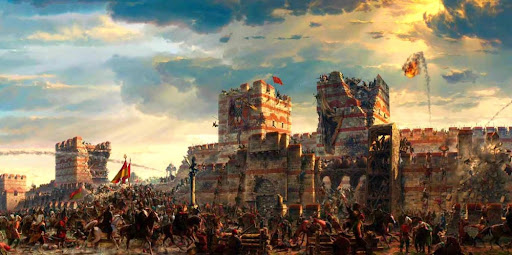1391, 1394, 1411, 1422 and 1453 — these are the dates when the Turks tried to take the capital of Byzantium. Five large-scale operations to capture the city, and only the last one ended in success. The number of attempts to seize Constantinople before the creation of the Ottoman Empire and do not count. Nevertheless, all the hardships, invasions of conquerors from different parts of Eurasia, coups d’état, riots and the terrible plague of 1347 the city worthily overcame. But before the army of the Turkish Sultan, who had acquired huge cannons, it could not withstand.
By the middle of the XV century, the Ottomans maximally strengthened, and Byzantium, on the contrary, weakened. In the same Constantinople of times of emperor Justinian I (VI century) lived, according to estimations of some historians, up to 500 thousand people! The city blossomed and was truly great and impregnable. But by the time of the siege of 1453, its population did not exceed 50 thousand inhabitants. So the process of absorption by a strong neighbor with imperial ambitions was predetermined — just the artillery of Sultan Mehmed II was the catalyst for the inevitable.

A monstrous bombardment at the siege of Constantinople in 1453. Artist: Christa Hook
Of course, the Turks’ success was not only due to a solid artillery fleet, presumably led by Hungarian engineer Urban. It is also due to the Ottoman fleet, which blockaded and shelled the city from the sea. And without many thousands land army which in the end and stormed walls of Tsargrad, and at all would not be that victory which has changed a course of a history. About 60000 soldiers worked on that siege on the part of Turks, while the Byzantium capital was defended about 7 thousand.
Although the siege lasted only 55 days, both sides suffered huge losses. The Ottoman Sultan irrevocably lost thousands of soldiers with each assault. Pain, suffering, and the death of comrades all affected the emotional state of the besiegers. And as a result of the heavy siege, the ground for cruelty, violence and plundering was created.
When Mehmed II’s Janissaries, sipahs, bashibuzuks and other troops entered the city, they “killed everyone who got in their way — both in the streets of the cities and in their own homes”. The victors were not very discerning about who was armed and resisting, and who was lost in an attempt to escape, so “no one was spared: neither husbands, nor wives, nor children”. Having had enough of blood, they began to rob all the inhabitants of Constantinople in an organized manner: “some plundered the houses of the noble citizens, and others plundered the shrines and seized public buildings.” Some of the Byzantines were taken captive by the Turks to be sold into slavery. “The spectacle was more terrible than any tragedy: the warriors captured chaste maidens from noble families, and the most beautiful, until then inaccessible to the male gaze, used themselves.”
It is curious that all the above quotations are taken from the work of the Byzantine writer Michael Kritovulus, who lived just at that time. And this very work he wrote by order of Sultan Mehmed II.

Turks in St. Sophia Cathedral in 1453. Artist: Marek Szyszko.
The same Kritovul wrote that the sultan was in tears when he entered Constantinople and saw what had happened: “What a city was given to ruin!”. Meanwhile, Mehmed II’s men went into every church and took out Christian relics. At the same time they robbed and killed the inhabitants who had taken refuge within the walls of the temples. The same fate befell those who hid in the Cathedral of St. Sophia. Its premises were literally crowded with people, and soon they also came for them. Lucky that day were those who got to the ships standing in the harbor and managed to escape from that nightmare by sea.
To be fair, a few days after the capture of Constantinople, Sultan Mehmed himself began to attract former residents to the city. He also freed the captives by allocating houses for them on the shore of the Golden Horn Bay. Some of them served as janissaries, and the rare ones could make their way to high positions. But the road to the political top required acceptance of Islam. Meanwhile, the financial sector was effectively placed under the control of Christians. The Sultan realized that there were areas where the former Byzantine aristocracy would do much better, and did not set them tough conditions. So the following conclusion is not an exaggeration: some Byzantines, especially those who were able to adapt, even benefited from Turkish expansion.
